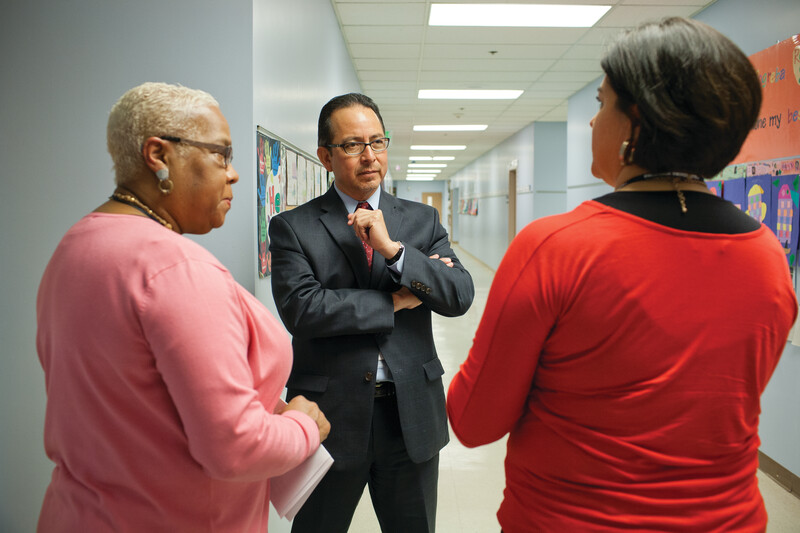How to find the passion to lead again.
We ask a lot of principals—especially now. They’ve always steered schools through difficult moments, and during the pandemic, they’ve had to field tough questions from their teachers and students while navigating complicated and sometimes contradictory guidelines from district and state leaders.
Even in the midst of these challenges, many have found new ways to engage their students, reenergize their colleagues, and uplift their communities. But it’s a daunting task, and one that will likely come with unexpected roadblocks as schools across the country reopen for in-person instruction—some for the first time in more than a year.
For ASCD author Jen Schwanke, that’s all the more reason to focus on recentering a school’s mission and to remind all educators of the reasons why their work is so important. In her new book, The Principal Reboot: 8 Ways to Revitalize Your School Leadership, the writer and professional development expert unpacks how school leaders can reorient themselves toward progress and strengthen the bonds between their colleagues.
Even in this time of masking and social distancing—when our physical surroundings have changed dramatically—some of the biggest barriers awaiting schools are social-emotional. After speaking with principals across the country recently, Schwanke noticed that although these educators were confident in their own leadership abilities, they were struggling with change. Burnout was taking a toll and leaving many well-intentioned leaders exasperated with a growing to-do list. As a school leader herself, she was feeling it, too. Something had changed since her first few years on the job. That moment of realization kickstarted her writing process.
“What if I could rediscover the excitement of those first few years? What if I could find ways to renew my purpose and joy for the job?” she writes. “What I needed, I decided, was a good old-fashioned reboot.”
Creating a Motivating Mission Statement
That “reboot” process encompasses a wide array of developments and adaptations. But it begins, according to Schwanke, with a realignment of goals and a reinvestment in the energy and passion many principals have at the outset of their careers.
“As any principal knows, it is easy to unwittingly lose focus and purpose—within ourselves, certainly, but also with our entire school community. We may assume we are moving in the right direction, because we are assiduously setting goals and creating improvement plans, but we can't be sure,” she explains. “There's no real way to know—not without an end point to guide us.”
To identify that end point, principals first need to conduct a “passion audit” in which they examine what they and their colleagues stand for and what motivates them. After that, they can begin to reconstruct a mission—a guiding light back to their early-career enthusiasm. As Schwanke writes, principals need to ask faculty, and themselves, deep questions, including:
- Do we have a statement, motto, mission, or vision that defines us?
- Can all teachers, students, and parents articulate what we are all about?
- How have the history and tradition of our school led to where we are now?
Once a school community has answers to those initial questions, they can turn to a more extensive list that will help them revise and hone their mission statement going forward.
- What history and tradition do we want to honor?
- What are our current demographics?
- Who is our audience?
- Do we all share the same goals? What are they?
- What kind of school do we want to be? One that gives back? One that is welcoming? A school that sings and dances?
- What does success look like for us?
- How can we put these ideas into words?
- When we find the words, how do we want our belief statement to sound? How can it have rhythm and soul, and easily roll off the tongue?
Those conversations should include more than just teachers and principals, says Schwanke. Students and families also have valuable input and can help school leaders understand what matters most about the work they do.
Once the entire community has an answer to the questions above, principals should step in to broadcast that guiding mission to everyone. That takes branding skills and a sense of creativity—things many educators have already had to develop to overcome the complex hurdles of the past year and a half. It also, importantly, should be fun. Write a song or make a new video with students advertising the school’s new goals, Schwanke advises. It’s worth the effort.
“Seeking answers to pointed questions about your school, while doubling down on efforts to address problems, can give you a boost of new energy and focus,” she writes. “Doing so will also reinforce your influence, improve your school's culture and morale, and reenergize your own reasons for being a principal. You'll have a rock-solid answer to the question ‘What are we trying to do here?’"
The guidance in this book can’t undo the complexities of leading a school in 2021. But with an open mind, principals can use the tools Schwanke provides to take on the challenges of today with assurance that they’re headed toward a happier, more successful tomorrow.
You can read the first chapter of Principal Reboot, which outlines the strategies in this post in more detail, here.








